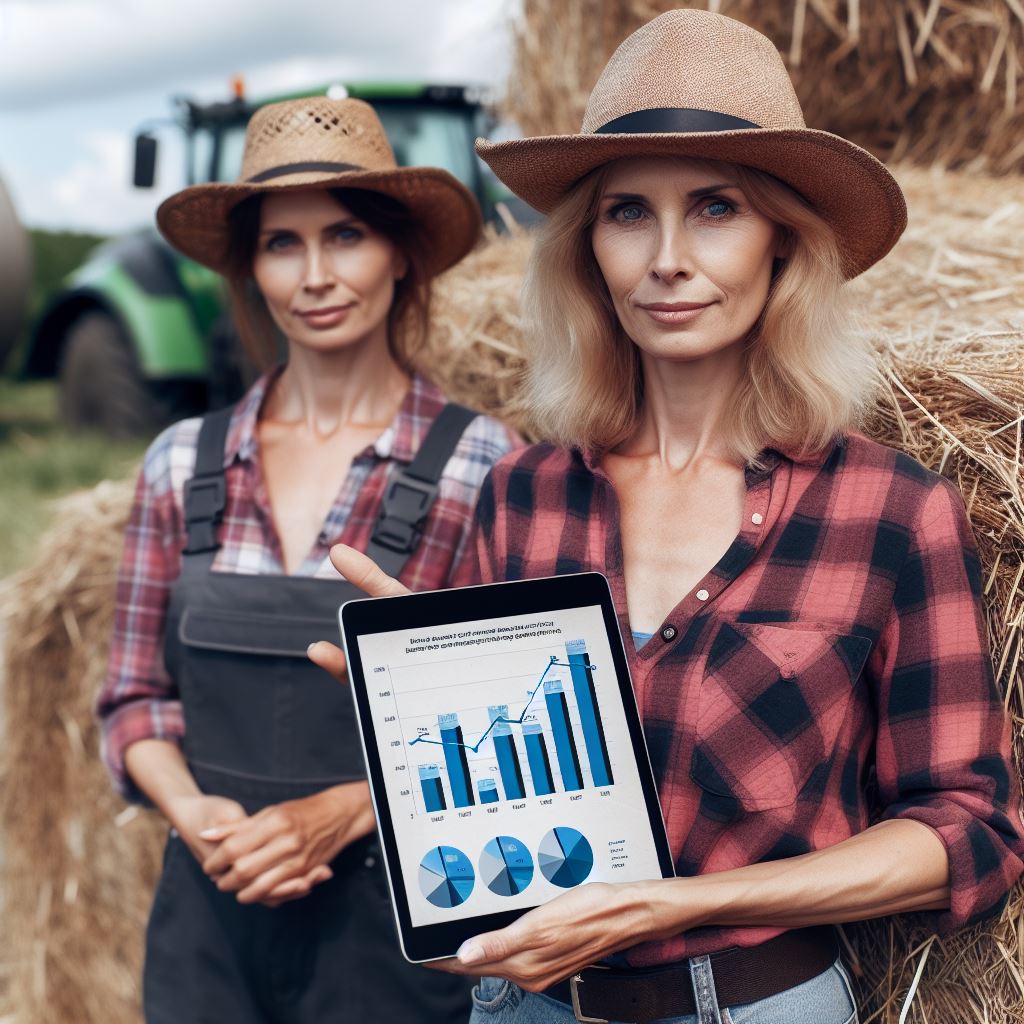Introduction
Livestock farmers play a vital role in the agricultural sector, contributing to food production and rural economies.
However, they often face various challenges, including fluctuating market prices, input costs, and weather-related risks.
Subsidies are essential for supporting livestock farmers by providing financial assistance and stability.
These subsidies help offset production costs, improve farm profitability, and ensure the sustainability of livestock operations.
By offering subsidies, governments aim to promote the growth and resilience of the livestock sector, enhance food security, and maintain rural livelihoods.
Subsidies can take various forms, such as direct payments, price supports, insurance programs, and grants for infrastructure development.
Additionally, subsidies may target specific aspects of livestock farming, such as animal health, genetics, or environmental stewardship.
Understanding the availability and eligibility criteria for subsidies is crucial for livestock farmers to leverage these resources effectively.
By accessing subsidies, farmers can invest in improved production practices, adopt sustainable technologies, and mitigate risks associated with livestock farming.
Basically, subsidies empower livestock farmers to overcome challenges, thrive in their operations, and contribute to a resilient and sustainable agricultural system.
What are subsidies?
Define subsidies and their purpose in relation to agriculture
Subsidies are financial aids provided by the government to support specific sectors, including agriculture.
They are aimed at promoting the growth of industries and leveling the playing field.
In relation to agriculture, subsidies serve to ensure food security, maintain a stable supply, and stimulate economic growth.
Livestock farmers can benefit greatly from subsidies as they face various challenges in their operations.
One way subsidies can support livestock farmers is by providing direct financial assistance.
Transform Your Agribusiness
Unlock your farm's potential with expert advice tailored to your needs. Get actionable steps that drive real results.
Get StartedThis assistance can be in the form of grants or reimbursements for certain expenses incurred in farming.
Subsidies can also help reduce the production cost for livestock farmers, making their products more competitive in the market.
By lowering the cost of inputs such as feed, medicines, and equipment, subsidies enable farmers to maintain profitability.
Moreover, subsidies can incentivize livestock farmers to adopt sustainable practices and improve animal welfare.
Through subsidies, farmers can receive financial rewards for implementing environmentally friendly methods and ethical treatment of animals.
Different types of subsidies available to livestock farmers.
There are different types of subsidies available to livestock farmers.
One common type is the input subsidy, which provides financial support for purchasing inputs such as fertilizers and machinery.
This type of subsidy helps farmers invest in better farm management practices, ultimately improving productivity.
Another type of subsidy is the income support subsidy, which supplements farmers’ income to stabilize their earnings.
This type of subsidy is often provided to help farmers cope with market fluctuations and price volatility.
Furthermore, there are subsidies specifically targeting livestock farmers engaged in organic farming or conservation efforts.
These subsidies aim to encourage sustainable agriculture practices and protect the environment.
Livestock farmers can also benefit from technical assistance subsidies, which provide knowledge and training to improve their skills.
These subsidies help farmers stay updated with the latest farming techniques and technologies for optimal productivity.
However, there are also challenges associated with subsidies for livestock farmers.
The distribution of subsidies can sometimes be unequal, favoring larger farms or corporations over smaller ones.
This can lead to an unfair advantage and hinder small-scale farmers’ growth and development.
Additionally, subsidies can create dependency among farmers, discouraging innovation and productivity improvements.
To ensure subsidies are efficiently utilized and distributed, proper monitoring and evaluation systems must be in place.
Therefore, subsidies play a crucial role in supporting livestock farmers and ensuring the sustainability of the agricultural industry.
They provide financial assistance, reduce production costs, and encourage sustainable practices.
Different types of subsidies are available depending on the specific needs of livestock farmers.
However, it is essential to address the challenges associated with subsidies to ensure fair distribution and promote innovation.
By continually assessing and adjusting subsidy programs, governments can effectively support and empower livestock farmers.
Showcase Your Farming Business
Publish your professional farming services profile on our blog for a one-time fee of $200 and reach a dedicated audience of farmers and agribusiness owners.
Publish Your ProfileRead: Food Safety: 2024’s Top Concerns
Benefits of subsidies for livestock farmers
Subsidies have been a crucial tool in improving the financial stability of livestock farmers.
Financial stability
- Subsidies offer financial support, allowing farmers to invest in their operations and improve productivity.
- They help offset the costs of production, such as purchasing feed, equipment, and maintaining infrastructure.
- By reducing financial burdens, subsidies enable farmers to focus on enhancing their livestock’s health and well-being.
Assistance during market uncertainty
- Subsidies act as a safety net, providing crucial assistance during unpredictable market conditions.
- Farmers may receive compensation for low market prices or unexpected market disruptions.
- This stability helps farmers maintain their operations and prevents them from leaving the industry.
Promoting sustainable farming practices
- Subsidies play a vital role in promoting sustainable livestock farming practices.
- Financial incentives encourage farmers to adopt environmentally friendly practices, such as waste management systems and conservation measures.
- Subsidies can support organic farming methods and the reduction of harmful chemical inputs.
Encouraging innovation and technological advancements
- Subsidies foster innovation and technological advancements in livestock farming.
- Financial support allows farmers to invest in research and development, leading to improved breeding techniques and disease prevention strategies.
- Subsidies can promote the adoption of new technologies, such as precision farming and automated feeding systems.
Overall, subsidies have numerous benefits for livestock farmers, helping them improve their financial stability.
In addition, subsidies provide essential assistance during uncertain market conditions, ensuring the sustainability of the industry.
Moreover, subsidies incentivize sustainable farming practices and drive technological advancements in livestock farming.
As we move forward, it is crucial to recognize the significance of subsidies in supporting and strengthening the livestock farming sector.
Read: Farm Tech Upgrades: Subsidy Options

Challenges associated with subsidies
Livestock farmers often face several challenges when it comes to subsidies.
These challenges can impact their business operations and hinder their ability to maximize the benefits of such programs.
Potential challenges associated with subsidies
- Complexity in accessing and navigating subsidy programs: Livestock farmers may find it challenging to understand the eligibility criteria, application process, and documentation requirements for subsidy programs. This complexity can discourage some farmers from even applying for subsidies.
- Lack of awareness: Many livestock farmers may not be aware of the subsidies available to them. Limited access to information or lack of outreach efforts by government agencies may result in farmers missing out on potential financial support.
- Administrative burden: The process of applying for subsidies can be time-consuming and bureaucratic. Farmers must gather and provide various documents, fill out forms, and meet deadlines, diverting their attention from core farming activities.
- Subsidy dependence and disincentives to improve efficiency: Some livestock farmers might become overly reliant on subsidies, leading to a decreased incentive to invest in improving their farming practices and overall efficiency. This dependence can hinder innovation and productivity in the sector.
- Inequitable allocation of subsidies: The allocation of subsidies may not always be equitable or fair to different types of livestock farming. Certain livestock sectors or regions might receive more substantial subsidies, while others are left with minimal support. This disparity can have a negative impact on smaller farmers or those in struggling sectors.
Possible complexities in accessing and navigating subsidy programs
- Lack of transparency: Subsidy programs might lack transparent guidelines on eligibility criteria, evaluation procedures, and fund allocation. This opacity can create confusion and unease among livestock farmers, discouraging their participation.
- Insufficient support infrastructure: Livestock farmers may lack the necessary support infrastructure to navigate subsidy programs effectively. Limited access to technological tools, agricultural extension services, or financial literacy programs can hinder their ability to access and utilize subsidies.
- Time constraints: The application period for subsidy programs may not align with the farming calendar. Farmers may face difficulties allocating time to complete applications during busy seasons, resulting in missed opportunities to benefit from subsidies.
The issue of subsidy dependence and potential disincentives to improve efficiency
- Reduced drive for innovation: When livestock farmers rely heavily on subsidies, they may become complacent and less motivated to adopt new technologies or practices that could enhance productivity and efficiency.
- Risk of stagnation: Subsidy dependence can lead to a lack of urgency to adapt to changing market conditions, ultimately hindering the competitiveness and long-term viability of livestock farming businesses.
- Budget constraints: Relying on subsidies can create a false sense of financial security, causing farmers to underinvest in their operations. This lack of financial risk-taking can impede the growth and modernization of the livestock sector.
The inequitable allocation of subsidies
- Favoritism towards certain livestock types: Subsidies may favor specific types of livestock farming, such as large-scale operations over small-scale or organic farming. This biased allocation can disadvantage farmers engaged in alternative or niche livestock production methods.
- Regional disparities: Certain regions may receive more subsidies due to political or economic considerations, leaving other areas with inadequate support. This imbalance can perpetuate inequalities in livestock farming and hinder regional development.
- Limited support for diversification: Subsidies may primarily focus on traditional livestock sectors, neglecting emerging or alternative practices. This lack of support can discourage farmers from diversifying their operations, hindering innovation and the development of sustainable livestock production.
Most importantly, while subsidies offer financial assistance to livestock farmers, they come with various challenges.
Complex application processes, subsidy dependence, inequitable allocation, and obstacles in accessing programs can hinder the full potential of subsidies in supporting livestock farming.
Addressing these challenges and ensuring fair and transparent subsidy schemes will be crucial for the sustainable growth and development of the livestock sector.
Read: Guide: Young Farmer Subsidies 2024
Government Subsidies and Regulations
The role of government in providing subsidies to livestock farmers is crucial for their economic stability and growth.
When applying for subsidies, livestock farmers go through a thorough process to ensure transparency and accountability.
There are specific regulations and criteria that livestock farmers must meet in order to qualify for subsidies.
These criteria often include factors such as herd size, animal welfare practices, and adherence to environmental standards.
Government oversight and monitoring play a vital role in ensuring the effectiveness and fairness of subsidy programs.
Regular inspections and audits are conducted to verify that farmers are complying with regulations and using subsidies appropriately.
The government also monitors the impact of subsidies on the overall agricultural landscape and adjusts policies accordingly.
One of the key benefits of government subsidies is the financial support they provide to livestock farmers.
These subsidies help offset costs for animal feed, veterinary care, infrastructure, and equipment, making it easier for farmers to stay in business.
Furthermore, subsidies can incentivize farmers to adopt sustainable practices and invest in improved animal welfare standards.
By promoting environmentally friendly practices, subsidies contribute to the long-term sustainability of the livestock sector.
Accessing subsidies usually involves submitting detailed applications outlining the farmer’s operation and compliance with regulations.
Financial records, herd health plans, and environmental impact assessments are often required as supporting documentation.
Process of applying for and accessing subsidies.
The application process can be time-consuming, but it ensures that funds are allocated to deserving farmers who meet the criteria.
Government agencies responsible for managing subsidies have protocols in place to review applications and distribute funds effectively.
The goal is to provide support to farmers who genuinely need assistance and contribute to the overall growth of the livestock sector.
It is essential for the government to ensure fairness in granting subsidies to prevent any potential misuse or favoritism.
Strict monitoring procedures help detect any fraudulent practices and maintain the integrity of the subsidy programs.
By doing so, the government can build public trust and confidence in the agricultural industry.
Overall, government subsidies and regulations are critical in sustaining and developing the livestock farming sector.
They provide financial support, incentivize sustainable practices, and enforce compliance with essential standards.
While the process of accessing subsidies can be rigorous, it ensures that funds are distributed fairly and transparently.
Continued government oversight is essential to adapt subsidy programs and ensure their long-term effectiveness.
Only through the collaboration between livestock farmers and the government can subsidies contribute to a thriving agricultural industry.
Read: Water Conservation Grants for Farms
Potential Future Changes in Subsidies for Livestock Farmers
Livestock farming is a crucial sector in the agricultural industry, providing meat, milk, and other animal products to meet the demands of the population.
Subsidy programs play a significant role in supporting livestock farmers and ensuring their profitability and sustainability.
Showcase Your Farming Business
Publish your professional farming services profile on our blog for a one-time fee of $200 and reach a dedicated audience of farmers and agribusiness owners.
Publish Your ProfileHowever, emerging trends and shifts in government priorities can impact these subsidy programs, requiring farmers to stay informed and adapt.
Let’s explore some potential future changes in subsidies for livestock farmers and how they can navigate through these changes.
Emerging Trends or Changes in Subsidy Programs
- Increasing focus on sustainable farming practices: Governments may introduce subsidies that promote environmentally-friendly livestock farming methods, such as reducing greenhouse gas emissions and improving waste management.
- Shift towards organic and free-range farming: Subsidy programs might shift to encourage livestock farmers to adopt organic farming practices or provide outdoor access for their animals to meet the growing consumer demand for ethically raised products.
- Introducing subsidies for alternative protein sources: With the rise of plant-based diets, governments may introduce subsidies to incentivize livestock farmers to diversify their production and explore alternative protein sources, such as plant-based or cultured meat.
- Focusing on animal welfare standards: Subsidies could be tied to meeting higher animal welfare standards, ensuring proper housing, health, and handling of livestock to address growing concerns about animal welfare among consumers.
Potential Shifts in Government Priorities or Policies
- Aligning subsidies with climate change goals: Governments may allocate more funds to support livestock farmers who implement climate change mitigation and adaptation strategies, fostering resilience in the face of changing environmental conditions.
- Redirecting subsidies towards small-scale and family-owned farms: There might be a shift in government policies to favor smaller livestock farms, encouraging local food production, improving rural economies, and fostering community sustainability.
- Supporting technology adoption: Governments may introduce subsidies to incentivize livestock farmers to adopt innovative technologies, such as precision farming, smart data analytics, and automation, to boost productivity and efficiency.
Staying Informed and Adapting to Potential Changes
- Regularly review agricultural policy updates: Livestock farmers should stay informed about any changes in government priorities, policies, and subsidy programs. This can be done by regularly checking official agricultural websites or subscribing to newsletters.
- Join industry associations and networks: Being a part of livestock farming associations or networks can provide valuable information and guidance regarding potential subsidy changes, as well as offer opportunities for collaboration and advocacy.
- Invest in education and training: Livestock farmers should continuously invest in upgrading their knowledge and skills to adapt to subsidy program changes. This can be done through attending workshops, seminars, or enrolling in relevant agricultural courses.
Diversify and innovate: To mitigate potential risks associated with subsidy changes, livestock farmers can explore diversifying their products, adopting new farming practices, or exploring alternative revenue streams, such as agritourism. - Build strong relationships with policymakers: Livestock farmers can actively engage with policymakers, participating in public consultations, presenting their concerns, and advocating for policies that support their industry’s sustainability and growth.
In short, the future of subsidies for livestock farmers is subject to ongoing changes and emerging trends.
Livestock farmers must proactively stay informed, adapt to potential shifts, and embrace innovative practices to ensure their long-term success and contribute to a sustainable agricultural industry.
Conclusion
This blog post highlighted the key points surrounding subsidies for livestock farmers.
Subsidies play a crucial role in supporting the livelihoods of these farmers by providing financial assistance and incentives.
They aid in reducing the financial burden and risks associated with running a livestock operation.
It is essential to reiterate the importance of subsidies for the sustainability and growth of the livestock farming industry.
These subsidies help farmers deal with unpredictable weather conditions, market fluctuations, and rising costs of inputs, ensuring the stability of their businesses.
We encourage readers to explore and take advantage of the available subsidy programs for their own livestock operations.
By accessing these subsidies, farmers can enhance their production techniques, invest in modern technologies, and improve the welfare and health of their livestock.
They can also expand their businesses and contribute to the economic development of rural areas.
By participating in subsidy programs, livestock farmers can not only improve the efficiency and competitiveness of their operations but also contribute to the overall food security of the nation.
It is crucial to stay updated on the latest subsidy opportunities and requirements, as they vary from region to region.
Subsidies are a vital lifeline for livestock farmers, and taking advantage of these programs can lead to sustainable and profitable farming practices.




